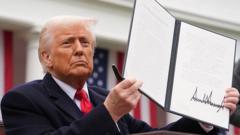The landscape of international trade is evolving as President Donald Trump's tariff tactics reap unexpected benefits, particularly with Japan now securing a new trade deal. Following extensive negotiations that had initially yielded little, the agreement signals a notable success for Trump's aggressive economic policies.
Japan has emerged with the best outcome among nations facing trade surpluses with the US, marked by a 15% tariff rate on its goods—surpassing the UK's 10%, aimed at its own trade imbalance. The negotiations highlighted the unusually intense frustration from Japanese officials, indicating the seriousness of the discussions.
The financial muscle Japan wields was apparent when its finance minister referred to the country's $1.1 trillion in US Treasury bonds as a negotiating lever—a reminder of potential consequences should negotiations falter. The deal is notable not only for its direct implications for US-Japan relations but also in its symbolic role for other global trading partners, including the European Union (EU).
As leaders from Japan host their EU counterparts, the timing is critical. The deal undermines any concerted countermeasures they might have considered responding to Trump’s tariffs. While Japan secured protective measures for its agricultural imports, it has agreed to import more US rice—asserting a careful balance between defense and cooperation.
Despite the Japanese government's prior reluctance to make concessions, the potential weight of Trump’s proposed 25% tariffs pushed them to act decisively. This broader acceptance of increasing tariffs among US allies signals an imminent shift in trade strategies worldwide.
Tariffs have become a significant revenue stream for the US Treasury, contributing over $100 billion this year alone, raising the proportion of federal income from tariffs significantly. Interestingly, while tariffs offer a temporary economic boost, the ultimate burden falls on American consumers. These tariffs coincide with a declining dollar, further escalating the cost of imported goods.
Amid these changes, the ramifications extend beyond the US and Japan. Comments from financial leaders like the Bank of England’s Andrew Bailey indicate a profound market transformation, suggesting a shift in traditional trade models and currency values. The weakening dollar may serve to enhance American competitiveness but also bolster rival nations like China, positioning them as stable trading partners.
Overall, this strategic maneuvering around tariffs and trade deals has immediate implications for the US economy, while also highlighting the complexities and uncertainties of the evolving global trade landscape. As Trump celebrates a win, the long-term economic consequences remain to be seen, painting a picture of both optimism and unease in equal measure.






















